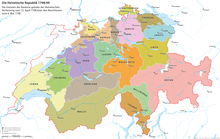Canton of Säntis
The canton of Säntis was a canton of the Helvetic Republic . It was formed in 1798 from the area of the city and prince abbey of St. Gallen , the bailiwick of the Rhine Valley and the two Appenzell . The canton was named after the example of the French departments , after a geographical feature, namely the mountain Säntis . The canton capital was St. Gallen . With the constitution of May 29, 1801, it was renamed Canton Appenzell .
history
According to the first draft of the Helvetic Constitution from spring 1798, the Prince Abbey of St. Gallen and the City of St. Gallen were to form the Canton of St. Gallen together. The former common lords of the Rhine Valley , Uznach , Rapperswil , Gaster and Sargans and the subject areas of Glarus and Zurich, Werdenberg and Sax-Forstegg would have been combined to form the canton of Sargans, while Glarus and Appenzell would have remained independent. After the refusal of the rural parish cantons to voluntarily adopt the Helvetic constitution, a new division was carried out after its violent submission with the aim of minimizing the weight of the votes of the stubborn cantons in the Helvetic Republic. For this reason, the new cantons Linth and Säntis were formed, in each of which those areas that were considered to be politically more reliable as former subject areas dominated the conservative population of the old cantons of Glarus and Appenzell.
With the mediation act of 1803, the sovereignty of the two Appenzell and Glarus was restored and the canton of St. Gallen was newly created by uniting the remaining areas of the cantons Säntis and Linth (excluding Höfe, March and Einsiedeln).
Administrative structure and demographics
The canton of Säntis had around 141,000 inhabitants and was divided into the following 13 districts:
- Sankt Gallen (11,200 inhabitants), main town St. Gallen
- Rorschach (10,100 inhabitants), main town Rorschach
- Lower Rhine Valley (10,000 inhabitants), main town Rheineck
- Upper Rhine Valley (11,000 inhabitants), main town Altstätten
- Appenzell (12,000 inhabitants), capital Appenzell
- Forest (12,000 inhabitants), main town Heiden
- Teufen (14,200 inhabitants), main town Teufen
- Herisau (13,000 inhabitants), main town Herisau
- Gossau (10,000 inhabitants), main town Gossau
- Wil (8,500 inhabitants), main town Wil
- Flawil (9,500 inhabitants), capital Flawil
- Mosnang (10,000 inhabitants), main town Mosnang
- Lichtensteig (10,000 inhabitants), main town Lichtensteig
literature
- Markus Kaiser: Let it be St. Gallen! Revolution, Helvetic, mediation and founding of the cantons 1793–1803. Office for Culture of the Canton of St. Gallen, St. Gallen 2003, ISBN 3-908048-42-7 .
- Patric Schnitzer: Säntis (Canton). In: Historical Lexicon of Switzerland .
Individual evidence
- ↑ The information on the number of inhabitants is based on contemporary estimates; according to Kaiser, Es Werde St. Gallen, p. 25.


